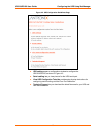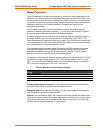
UDS10/UDS100 User Guide Configuring the UDS Using Telnet or the Serial Port
25
Note: Class A: 24 bits; Class B: 16 bits; Class C: 8 bits.
The unit prompts for the number of host bits to enter, then calculates the netmask,
which displays in standard decimal-dot notation when the saved parameters display
(for example, 255.255.255.0).
Table 5-1. Standard IP Network Netmasks
Network Class Host Bits Netmask
A 24 255.0.0.0
B 16 255.255.0.0
C 8 255.255.255.0
Table 5-2. Netmask Examples
Netmask Host Bits
255.255.255.252 2
255.255.255.248 3
255.255.255.240 4
255.255.255.224 5
255.255.255.192 6
255.255.255.128 7
255.255.255.0 8
255.255.254.0 9
255.255.252.0 10
255.255.248.0 11
... ...
255.128.0.0 23
255.0.0.0 24
Change Telnet configuration password
Setting the Telnet configuration password prevents unauthorized access to Setup
Mode using a Telnet connection to port 9999 or using Web pages. The password is
limited to 4 characters. An enhanced password setting of 16 characters is available
under Security Settings.
Note: No password is required to access the Setup Mode using a serial
connection.
DHCP Naming
A DHCP name is a unique identifier used for managing multiple DHCP hosts on a
network. Your unit ships with a default DHCP name of Cxxxxxx, where xxxxxx is the
last six digits of the Mac address.
You can change the DHCP name (up to eight characters) when configuring the
server in Setup Mode. Change the DHCP name to LTXdd, where 0.0.0.dd is the IP
address assigned (dd should be a number between 1 and 99). For example, if the IP
address is set to 0.0.0.5, the resulting DHCP name is LTX05.


















